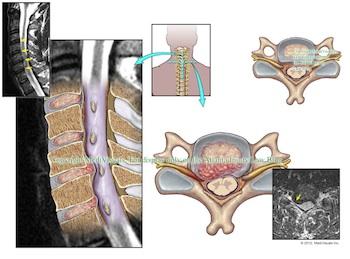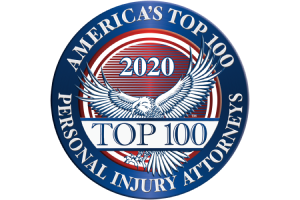Like Family.
Herniated Cervical Disc
A herniated cervical disc is one of the injuries we see most often see as personal injury attorneys based in metro Atlanta and practicing statewide in Georgia. A herniated cervical disc may result from any motor vehicle accident, including an automobile or car wreck or a truck, tractor trailer, semi or big rig accident.
The spine is a stack of bones called vertebra. Nerves run out from the spinal cord, which is in the middle of the spine, to all parts of the body. The vertebra are separated by shock absorbers called intervertebral discs. The discs are often compared to a jelly donut. The outer layer (the “bread” of the donut) is the annulus fibrosus, a tough tissue comprised of several layers of fibrocartilage. This layer contains the nucleus pulposus (the “ jelly ” of the donut) and distributes pressure evenly across the disc.
There are normally 23 discs in the hum your spine: 6 in the neck (cervical region), 12 in the middle back (thoracic region), and 5 in the lower back (lumbar region). They are called by letters and numbers according to location. For example, the disc between the fifth and sixth cervical vertabrae is designated “C5-6.”
When there is an injury to the disc, the bread of the donut weakens and cracks and the jelly begins to protrude outward. There may be a bulge in the disc so that it pinches nerves causing pain, numbness or tingling. When the jelly leaks out of the donut, it is called a herniation. Often a disc herniation causes disabling pain or loss of bodily function.
As people age, annulus fibrosus gets weaker with age and begins to crack, and the nucleus pulposus begins to dehydrate, which limits its ability to absorb shock. The These age related changes may not cause any symptoms for many decades until some event such as a car or truck collision causes trauma that aggravates or exacerbates the degenerative condition.
Because a person with age related degeneration may do just fine until trauma causes severe pain, numbness, tingling or loss of bodily functions, in insurance claims and injury litiation we generally address such injuries as aggravations of preexisting conditions. The few exceptions are when post-accident xrays, CT scans and MRI images show a fresh fracture of a vertebra. We embrace preexisting conditions that were previously asymptomatic and make them part of the client’s case.


We often see clients who have had cervical disc herniation injuries due to automobile or truck collisions. Typically, orthopedic surgeons and neurosurgeons prescribe conservative treatment with physical therapy a series of injections in the spine. If symptoms still persist, they will discuss with the patient surgical options. For cervical (neck) injuries, we most often see anterior cervical fusion surgery in which an incision is made in the front of the neck, the damaged disc is removed, replaced with bone tissue (from the patient’s own hip or donor bone tissue), and the vertebra secured with a metal plate and screws. Sometimes a newer model of flexible artificial disc is used. While results vary, we usually hear from clients that the surgery greatly improves their quality of life and ability to engage in normal activities without significant pain.
With long experience representing clients with intervertebral disc injuries, we are able to handle such cases efficiently and guide most such cases to optimal resolutions through pretrial settlement or jury verdicts.
Ken Shigley is Immediate Past President of the State Bar of Georgia and currently chair of the board of the Institute for Continuing Legal Education in Georgia, so he is well respected among judges, lawyers and court officials across Georgia. He has successfully handled cases in many of Georgia’s 159 counties from the mountains to the sea. Mr. Shigley has dual board certification in Civil Trial Advocacy and Civil Pretrial Advocacy from the National Board of Legal Specialization. He has spoken on continuing legal education programs from coast to coast and is now on the boards of the American Association for Justice Motor Vehicle & Premises Liability Section and Trucking Litigation Group.












